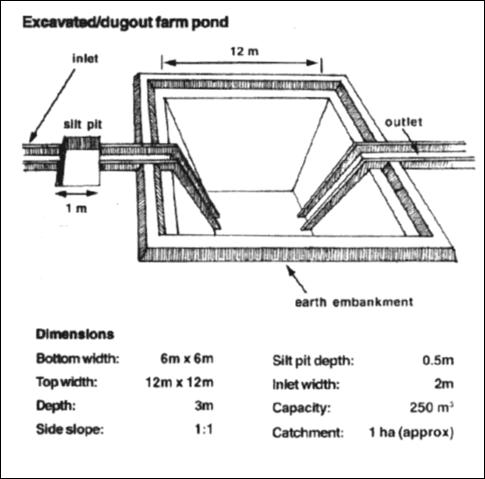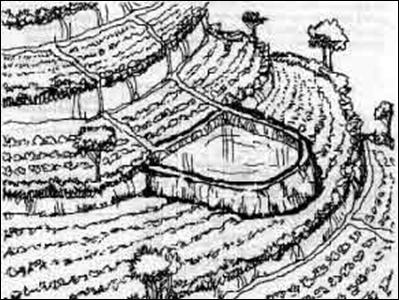The ideal farm pond should be dug into the ground in a naturally low-lying area. Some of the soil that is removed can be used to construct an earthen berm around the pond, which should be planted with trees and grasses for stability. The shade and wind protection provided by the raised mound and vegetation will reduce evaporative losses. Greater depth of the pond and less surface area will also reduce evaporative losses. However, digging deeper than 5 meters will increase the expense of the digging, and increase seepage loss due to increased water pressure on the ground. A pond that is about 10 meters by 10 meters and 3 meters deep is an ideal size. The pond should have an inlet and an outlet (as shown in the picture) lined with rock to prevent erosion. These features will need to be linked into a larger drainage plan which directs water into the pond, and receives any overflow water. A small settling pit at the inlet will help remove silt, and can be more easily cleaned than the whole pond. The sides of the pond should be sloped for stability.

The pond should be sized to hold about 50% of maximum runoff, so that it will fill up even in a dry year. Maximum runoff can be calculated by considering rainfall intensity and duration, watershed area, and slope, soil type, and land-use throughout the watershed. A rough estimate is that a 1 hectare watershed in red soil can yield 250 cubic meters of water, which is enough to fill the pond shown in the picture on the previous page. Individuals with some expertise in hydrology can develop such rules of thumb relevant to the physical characteristics of particular regions.
Another question is whether the pond will be discharging or recharging. If the pond is higher in the watershed and / or the soil is permeable, it may function more as a percolation pit than as a pond. If the pond is lower in the watershed and the water table is high, it may naturally fill with groundwater. It is important to decide whether the goal is to facilitate infiltration of water, or to maintain surface water in the pond, which can be easily accessed for water needs. In the latter case, it may be necessary to line the pond to reduce permeability. Possible linings include: clay, bentonite, stone or brick, cement, rubber, plastic, etc. If a farm pond maintains water for 80 percent of the year it can also be used for raising fish.
If it is not possible to create a sunken pond because the soil is too shallow, or excavation is too expensive, one can build walls on the surface to create a surface pond. This picture shows a combination of terraces, channels, and surface pond.

/articles/how-create-farm-pond-water-storage